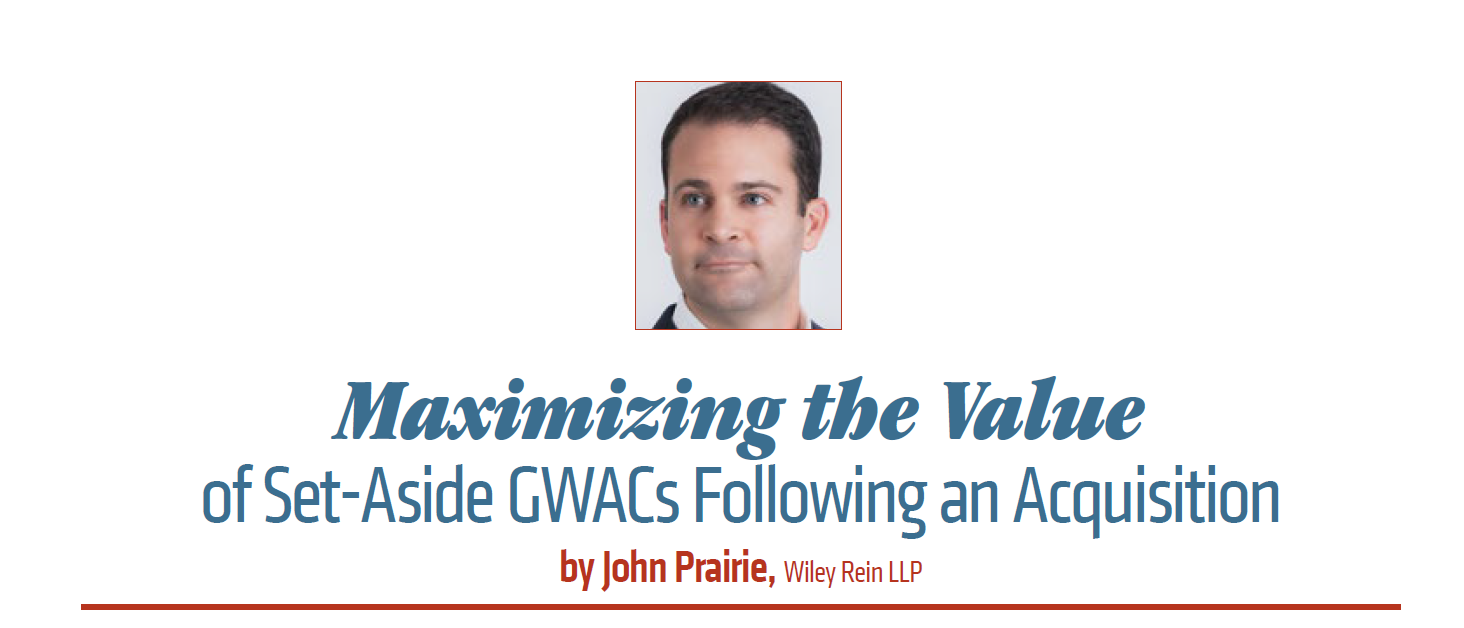
Notwithstanding the many challenges of the past year, merger and acquisition activity remains relatively robust in the government contracts market. This is particularly the case for small and medium-sized professional services and technology contractors, as larger contractors look to increase scale, add new capabilities, or access new federal markets and customers. Acquisitions are also a good way for the acquiring entity to get a seat on government wide acquisition contracts (GWACs) held by the target firm if, for example, the acquiring entity was not eligible because some or all of the GWAC awards were set aside for small business.
Acquisitions of small business contractors have always raised thorny questions about what happens to the target firm’s set-aside contracts post-transaction. GWACs warrant special attention because the rules are complex and agency practices can vary widely from one contract to the next. Whether and the extent to which the target firm can continue to perform and pursue work under the GWAC can have a significant impact on valuation and the business case for the deal.
Most contractors understand that following an acquisition, the target firm must re-represent its size and socioeconomic status in accordance with FAR 52.219-28. But, if the target firm recertifies as other than small, what does that mean going forward? Understanding the rules that apply can help contractors maximize the value of set-aside GWACs post-acquisition.
Can the target firm keep performing its existing work under the GWAC?
Almost universally, yes. Under Small Business Administration (SBA) regulations, the target firm can continue performing its existing work but the agency cannot count new options towards its small business goals. This is rarely an issue. Although an agency always has the discretion not to exercise an option on an order issued under the GWAC (or terminate the order for its convenience), agencies almost always permit acquired firms to continue performing their existing work until completion. Many GWACs contain clauses stating so explicitly.
Contractors should still review GWACs carefully to ensure the change in size status does not affect other contract requirements. For example, some GWACs require a certain percentage of small business participation on task orders. Following an acquisition, the target firm may have to reallocate work on certain task orders to ensure it remains in compliance. Also, in some cases, agencies will require the target firm to submit a small business subcontracting plan now that it no longer qualifies for an exception from that requirement.
Can the target firm pursue new set-aside work under the GWAC?
It depends. SBA regulations provide that the agency cannot count new orders issued to the target firm towards its small business goals. But the regulations do not automatically render the target ineligible for new set-aside orders post-transaction. Rather, it is up to the agency to decide whether to require firms to recertify their size status for orders issued under the GWAC. If not, the target would remain eligible for new orders based on its original size certification for the GWAC.
It has become increasingly common for GWACs to include clauses specifically addressing this scenario. For example, the OASIS Small Business Pool 1 Contract provides that if a contractor becomes other than small as a result of an acquisition, the contract will be placed in “Dormant Status” and the contractor will be Off-Ramped once all active task orders are closed out.
In a recent rule change, SBA clarified how an acquisition affects the target firm’s pending proposals. Under the new rule, if the acquisition occurs after offer but prior to award, the offeror must recertify its size to the contracting officer prior to award. If the acquisition (including agreements in principal) occurred within 180 days of the date of an offer and the offeror is unable to recertify as small, it will not be eligible to receive the award. If the acquisition occurred more than 180 days after the date of an offer, however, the offeror is eligible for award but the agency cannot count the award towards its small business goals.
Can the target firm pursue new full-and-open work under the GWAC?
Sometimes. There are no regulations specifically addressing this issue, so the answer is left up to each individual contracting agency and/or the terms of the GWAC in question. In many cases, agencies have unwritten policies of allowing contractors to transition from the set-aside pool on a GWAC to the full-and-open pool following an acquisition. It is important to explore this during due diligence to understand the agency’s policy for a particular GWAC.
Some GWACs specifically address this issue. For example, the OASIS Small Business Pool 1 Contract provides that if a contractor becomes other than small as a result of an acquisition, the contractor is not eligible for Lateral Pool Ramping or Vertical Contract On-Ramping to full-and-open pools. By contrast, the Air Force’s Training Systems Acquisition III contract expressly provides that “[i]f a Small Business TSA III prime contract holder recertifies as a large business during the TSA III ID/IQ contract period of performance[,] that company will be considered a large business prime in the Unrestricted Pool for the remainder of the TSA III ID/IQ period of performance.” So it is critical to closely review the terms of each GWAC to determine the target’s eligibility for new full-and-open work.
Conclusion
Acquisitions are great opportunities to expand the business of both the acquiring and target firms. When set-aside GWACs are involved, it is important to understand the impact of the acquisition to best position the firms to leverage the GWAC for future success.
This article appears in the Spring 2021 Service Contractor.